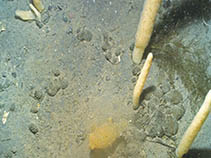Distaplia cylindrica (Lesson, 1830)
Sea rod| Native range | All suitable habitat | Point map | Year 2050 |

|
| This map was computer-generated and has not yet been reviewed. |
| Distaplia cylindrica AquaMaps Data sources: GBIF OBIS |
Classification / Names Populärnamn | synonymer | CoL | ITIS | WoRMS
Ascidiacea | Aplousobranchia | Holozoidae
Environment: milieu / climate zone / djupintervall / distribution range Ekologi
; djupintervall 0 - 1000 m (Ref. 3435). Polar
Distribution Länder | FAO områden | Ekosystem | Förekomster | Utplanteringar
Southwest Atlantic, Southeast Pacific and the Antarctic: From Antarctica to South America.
Length at first maturity / Size / Weight / Age
Könsmognad: Lm ? range ? - ? cm Max length : 8.0 cm COLD hane/ej könsbestämd; (Ref. 3373)
Life cycle and mating behavior Könsmognad | Reproduktion | Lek | Eggs | Fecundity | Larvae
Main reference
referenser | Koordinator | Medarbetare
Tatian, M., R.J. Sahade, M.E. Doucet and G.B. Esnal 1998 Ascidians (tunicata, ascidiacea) of Potter cove, South Shetland Islands, Antarctica. Antarc. Sci. 10(2):147-152. (Ref. 1753)
IUCN Red List Status
(Ref. 130435: Version 2025-1)
CITES status (Ref. 108899)
CMS (Ref. 116361)
Threat to humans
Human uses
| FishSource |
Verktyg
Ytterligare information
Födosammansättning
Födointag
Predatorer
Max. ages / sizes
Length-weight rel.
Length-length rel.
Length-frequencies
Mass conversion
Abundans
Internet-källor
BHL | BOLD Systems | CISTI | DiscoverLife | FAO(Publication : search) | Fishipedia | GenBank (genome, nucleotide) | GloBI | Gomexsi | Google Books | Google Scholar | Google | PubMed | Tree of Life | Wikipedia (Go, sök) | Zoological Record



